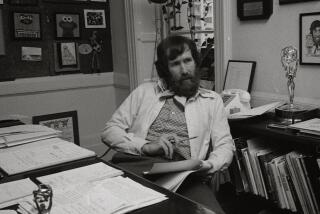Mary Ritts, 95; She and Husband Had a Long TV Run With Ritts Puppets
- Share via
Mary Ritts, who with her husband, Paul, created and performed the Ritts Puppets, a popular act that appeared regularly on television for three decades beginning in the early 1950s and made a memorable appearance in Jerry Lewis’ film “The Errand Boy,” has died. She was 95.
Ritts died May 14 of natural causes in a retirement home in Pasadena, said her son, Mark Ritts.
The Ritts Puppets -- a menagerie that originally included Geoffrey the Giraffe, Albert the Chipmunk, Calvin the Crow and Magnolia the Ostrich -- debuted on “In the Park,” a Sunday family TV series on CBS from 1951 to 1953 starring Bill Sears.
Mary Ritts supplied the voice for Magnolia the Ostrich, a quintessential Southern belle with long eyelashes and a soprano singing voice. Her husband provided the voices for the male puppets.
The Ritts Puppets were hosts of “The Pink Panther Show,” an NBC Saturday morning series, for several years in the early 1970s. They also were featured performers on “Exploring,” an NBC science series for young people in the ‘60s, and “The Watch Your Child/The Me Too Show,” a daily program for preschoolers on NBC in the ‘70s.
In addition to regular appearances on “The Ed Sullivan Show,” “The Tonight Show” and other variety and talk shows, the Ritts Puppets starred in three network TV specials, and Columbia recorded an album of the couple’s original children’s songs.
Paul and Mary Ritts also were the co-hosts of “Family,” a live, daily hourlong show featuring celebrity interviews, puppet vignettes and live keyboard music played by Mary that aired on WNBC in New York for three years in the early 1960s.
A number of guest shots on the show by Jerry Lewis led to two of the Ritts’ puppets appearing in “The Errand Boy,” Lewis’ 1961 comedy set in a movie studio.
In one scene with no dialogue, Lewis visits a prop storeroom and discovers Bobo the Clown on a shelf. The little clown hand puppet comes to life and gives Lewis a lollipop. The puppet then places a little bed on the shelf, fluffs up the mattress, tries to get the blanket tucked in and finally falls asleep -- as does Lewis.
When Lewis later returns to the storeroom shelf to see the little clown, he instead finds Magnolia the Ostrich, who listens to his job tribulations. When Lewis realizes he is talking to a doll, Magnolia reassures him that she is as real as he makes her. She then urges Lewis to believe in himself as much as he believes in her.
The two scenes provided quiet, sweet interludes in the sometimes raucous comedy.
“Bobo the Clown originally was just a throwaway prop that my father made for one of the puppet bits for the ‘Family’ show,” Mark Ritts said. “He was a little rubber clown hand puppet that he bought at a 5 and 10 cent store and repainted. He was a mute character that just did pantomime.”
During one of Lewis’ appearances on the “Family” show, he said, Lewis “went nuts for Bobo.”
As a result, he said, “Bobo became much more prominent than my parents ever intended him to be because of the love affair between Bobo and Jerry. It reached the point where every time Jerry Lewis was on the show, there was always one of those really touching interludes without dialogue between Bobo and Jerry, rather like you see in ‘The Errand Boy.’
“They were always done in extreme close-ups; very intimate scenes. I remember the cameramen used to get tears in their eyes during the scenes between Bobo and Jerry. It would be very emotional. They’d be very tight on Jerry [with the camera], and Jerry’s eyes would fill with tears.”
The couple’s puppetry career began in the early 1950s, when Paul Ritts, a former Armed Forces Radio announcer, was directing a sportscast at WCAU-TV, the CBS-owned station in Philadelphia. “They wanted a hook for the show, and they thought it would be funny if a little animal lived in the filing cabinet of the sportscaster to help deliver the sports news,” Mark Ritts said. “No one was a puppeteer at the station. But my father, who had had built model airplanes as a kid, said, ‘I’ll make you a puppet.’ ”
He went home and carved a puppet named Albert the Chipmunk out of balsa wood; Mary Ritts, a trained artist, painted it.
Viewers fell in love with Albert the Chipmunk, whose voice was provided by Paul Ritts. Ritts and sportscaster Sears then decided to expand the concept and create more puppets for what became “In the Park.”
“My parents together made the three primary puppets: Albert Chipmunk, Geoffrey Giraffe and Calvin Crow,” Mark Ritts said. “Then they decided they needed a female character, and Magnolia the Ostrich was born, along with my mother’s career as a puppeteer. “
From then on, he said, puppetry became his parents’ primary career.
Mary Ritts, whose maiden name was Donnelly, was born June 16, 1910, in Philadelphia. After graduating from the Pennsylvania Academy of Fine Arts in Philadelphia, she became a fashion illustrator for Bonwit Teller, John Wanamaker and Stetson hats, and her work appeared frequently in Vogue and Harper’s Bazaar.
Paul Ritts, who was 10 years younger than his wife, died in 1980 at age 60.
“They were so inextricably a duo that when my dad died, the [puppet] act pretty much died with it,” Mark Ritts said.
In addition to her son, Mary Ritts is survived by three grandchildren.
More to Read
The biggest entertainment stories
Get our big stories about Hollywood, film, television, music, arts, culture and more right in your inbox as soon as they publish.
You may occasionally receive promotional content from the Los Angeles Times.










